Quantitative Integration of Audio-Magnetotelluric Sounding and Resistivity Well Logs for Groundwater Studies
Abstract
1. Introduction
2. Materials and Methods
2.1. Study Area
2.2. Geological and Hydrogeologycal Background
2.3. Geophysical Methods
2.3.1. Magnetotelluric Method
[−Zxγ 0]
2.3.2. Well Log Resistivity
2.3.3. Magnetotelluric Data Acquisition
2.4. Well Log Data Acquisition
2.5. Synthetic Model
2.6. AMT Inversion Model and Upscaling
3. Results
3.1. Validation of the Synthetic 1D Model
3.2. Data Inversion AMT
3.3. Reference Model vs. AMT Layer-Inverted Model (LIM)
4. Discussion
Supplementary Materials
Author Contributions
Funding
Data Availability Statement
Acknowledgments
Conflicts of Interest
Abbreviations
| AMT | Audio-magnetotelluric |
| MT | Magnetotelluric |
| RMT | Radio Magnetotelluric |
| MEGIA | Multiscale Integrated Water Management Model Project (from its Spanish acronym Modelo Multiescala de Gestión Integral del Agua) |
| MMV | Middle Magdalena Valley |
| RMS | Root Mean Square |
| RMSE | Root Mean Square Error |
| RM | Reference model |
| LIM | Layer inversion model |
| MMB | Middle Magdalena Basin |
| Qfal | Floodplain deposits |
| Qfl | Fluviolacustrine deposits |
| N1r | Real Group |
| DOI | Depth of investigation |
References
- Ren, Z.; Kalscheuer, T. Uncertainty and Resolution Analysis of 2D and 3D Inversion Models Computed from Geophysical Electromagnetic Data. Surv. Geophys. 2020, 41, 47–112. [Google Scholar] [CrossRef]
- Sonkamble, S.; Sahya, A.; Mondal, N.C.; Harinarayana, T. Electrical Resistivity and Hydrochemical Indicators Distinguishing Chemical Characteristics of Subsurface Pollution at Cuddalore Coast, Tamil Nadu. J. Geol. Soc. India 2014, 83, 535–548. [Google Scholar] [CrossRef]
- Goebel, M.; Pidlisecky, A.; Knight, R. Resistivity imaging reveals complex pattern of saltwater intrusion along Monterey coast. J. Hydrol. 2017, 551, 746–755. [Google Scholar] [CrossRef]
- Gottschalk, I.; Knight, R.; Asch, T.; Abraham, J.; Cannia, J. Using anAirborne Electromagnetic Method to Map Saltwater Intrusion in the Northern Salinas Valley, California. Geophysics 2020, 85, B119–B1131. [Google Scholar] [CrossRef]
- Golshan, A.; Sadeghi, M.; Sadeghi, M. Assessing Aquifer Salinization with Multiple Techniques along the Southern Caspian Sea Shore (Iran). Water 2018, 10, 348. [Google Scholar] [CrossRef]
- McLachlan, P.J.; Chambers, J.E.; Uhlemann, S.S.; Binley, A. Geophysical Characteriation of the Groundwater–Surface Water Interface. Adv. Water Resour. 2017, 109, 302–319. [Google Scholar] [CrossRef]
- Ali, N.; Chappuies, J.; Sloan, G.; Rouland, G.; Rai, A.; Dong, Y. A Global Perspective on Electrical Resistivity Tomography, Electromagnetic and Ground Penetration Radar Methods for Estimating Groundwater Recharge Zones. Front. Water 2025, 7, 1636613. [Google Scholar] [CrossRef]
- Baloyi, L.; Kanyerere, T.; Muchingami, I.; Pienaar, H. Application of Hydrogeophysical Techniques in Delineating Aquifers to Enhancing Recharge Potential Areas in Groundwater-Dependent Systems, Northern Cape, South Africa. Water 2024, 16, 2652. [Google Scholar] [CrossRef]
- de Oliveira, R.A.; Santos, E.; Medeiros, W.E.; Dourado, J.C. Hydrogeophysical Characterization of Groundwater Conductors Using Integrated Audio-Magnetotelluric and Electrical Resistivity Data in the Sienito Coreaçu Region, Brazil. In Proceedings of the 16th International Congress of the Brazilian Geophysical Society and Expogef, Rio de Janeiro, Brazil, 19–22 August 2019; pp. 1–6. [Google Scholar]
- Krivochieva, S.; Chouteau, M. Integrating TDEM and Magnetotelluric Methods for Characterization and Delineation of the Santa Catarina Aquifer (Chalco Sub-Basin, Mexico). J. Appl. Geophy. 2003, 52, 23–43. [Google Scholar] [CrossRef]
- Ritz, M.; Descloitres, M.; Robineau, B.; Courteaud, M. Audiomagnetotelluric Prospecting for Groundwater in the Baril Coastal Area, Piton de La Fournaise Volcano, Réunion Island. Geophysics 1997, 62, 758–762. [Google Scholar] [CrossRef]
- Falgàs, E.; Ledo, J.; Marcuello, A.; Queralt, P. Monitoring Freshwater–Seawater Interface Dynamics with Audiomagnetotelluric Data. Near Surf. Geophys. 2009, 7, 391–400. [Google Scholar] [CrossRef]
- Ullah, S.; Saibi, H.; Akhtar, M.; Abueladas, A.; Al-Ruwaili, K. Audio-Magnetotelluric Survey for Groundwater Investigation in the Al-Jaww Plain, in Eastern Abu Dhabi, Al-Ain, United Arab Emirates. Earth Space Sci. 2023, 10, e2023EA003181. [Google Scholar] [CrossRef]
- Saibi, H.; Cherkose, B.A.; Ismail, F.; Alhashmi, K.; Safiuddin, R.; Alzeyoudi, A.; Almaramah, L.; Al Senani, S.; Alkaabi, M.; Shion, N.; et al. Groundwater study using Audio-Magnetotelluric Data at Falaj Mazyad in the eastern Abu Dhabi Emirate, Al-Ain region, UAE. In Proceedings of the International Conference on Engineering Geophysics (ICEG), Al Ain, United Arab Emirates, 16–19 October 2023. [Google Scholar]
- Falade, A.O.; Bewaji, S.; Olagunju, B.D. Electrical Resistivity and Magnetotelluric Integration for Groundwater Exploration at the Proposed Central Library in Achievers University Owo, Nigeria. Appl. Geophys. 2025, 3, 99. [Google Scholar] [CrossRef]
- Gomo, M. Use of Electric Potential Difference in Audio Magnetotelluric (AMT) Geophysics for Groundwater Exploration. Groundw. Sustain. Dev. 2023, 20, 100864. [Google Scholar] [CrossRef]
- Hoversten, G.M.; Morrison, H.F.; Constable, S.C. Marine Magnetotellurics for Petroleum Exploration, Part II: Numerical Analysis of Subsalt Resolution. Geophysics 1998, 63, 826–840. [Google Scholar] [CrossRef]
- Tang, J.-T.; Liu, Z.-J.; Liu, F.-Y.; Xie, Y. The Denoising of the Audio Magnetotelluric Data Set with Strong Interferences. Chin. J. Geophys. 2015, 58, 4636–4647. [Google Scholar] [CrossRef]
- Hossain, A.M. Development of a Model to Estimate Groundwater Recharge. J. Groundw. Sci. Eng. 2025, 13, 406–422. [Google Scholar] [CrossRef]
- Goebel, M.; Knight, R.; Halkjær, M. Mapping Saltwater Intrusion with an Airborne Electromagnetic Method in the Offshore Coastal Environment, Monterey Bay, California. J. Hydrol. Reg. Stud. 2019, 23, 100602. [Google Scholar] [CrossRef]
- Sonkamble, S.; Sahya, A.; Jampani, M.; Ahmed, S.; Amerasinghe, P. Hydro-Geophysical Characterization and Performance Evaluation of Natural Wetlands in a Semi-Arid Wastewater Irrigated Landscape. Water Res. 2019, 148, 176–187. [Google Scholar] [CrossRef] [PubMed]
- Vouillamoz, J.-M.; Descloitres, M.; Bernard, J.; Fourcassier, P.; Romagny, L. Application of Integrated Magnetic Resonance Sounding and Resistivity Methods for Borehole Implementation: A Case Study in Cambodia. J. Appl. Geophy. 2002, 50, 67–81. [Google Scholar] [CrossRef]
- Ismail, N.; Schwarz, G.; Pedersen, L.B. Investigation of Groundwater Resources Using Controlled-Source Radio Magnetotellurics (CSRMT) in Glacial Deposits in Heby, Sweden. J. Appl. Geophy. 2011, 73, 74–83. [Google Scholar] [CrossRef]
- de Oliveira, T.P.; La Terra, E.F.; Panetto, L.P.; Fontes, S.L.; Maurya, V.P.; Nacional, O. Hydrogeophysical Characterization of Groundwater Conductors and Storage Geological Structures Through Audiomagnetotelluric and Electrical Resistivity Tomography Methods; SBGf: Rio de Janeiro, Brazil, 2019. [Google Scholar]
- Jiang, W.; Roach, I.C.; Doublier, M.P.; Duan, J.; Schofield, A.; Clark, A.; Brodie, R.C. Application of Audio-Frequency Magnetotelluric Data to Cover Characterisation—Validation against Borehole Petrophysics in the East Tennant Region, Northern Australia. Explor. Geophys. 2023, 55, 466–485. [Google Scholar] [CrossRef]
- Best, M.E. Electromagnetic (EM) Methods. In Shear Wave Velocity Measurement Guidelines for Canadian Seismic Site Characterization in Soil and Rock; Hunter, J.A., Crow, H.L., Eds.; General Information Product 110e; Geological Survey of Canada, Earth Science Sector: Ottawa, ON, Canada, 2015; pp. 170–180. [Google Scholar]
- Carmichael, R.S. Practical Handbook of Physical Properties of Rocks and Minerals, 1st ed.; CRC Press: Boca Raton, FL, USA, 1989. [Google Scholar]
- Telford, W.M.; Geldart, L.P.; Sheriff, R.E. Applied Geophysics, 2nd ed.; Cambridge University Press: Cambridge, UK, 1990. [Google Scholar]
- Yan, P. Inversion of Magnetotelluric Data Constrained by Borehole Logs and Reflection Seismic Sections. Ph.D. Thesis, Uppsala University, Uppsala, Sweden, 2016. [Google Scholar]
- Simpson, J.M.; Heinson, G. Synthetic Modelling of Downhole Resistivity Data to Improve Interpretation of Basin Morphology from Magnetotelluric Inversion. Earth Planets Space 2020, 72, 69. [Google Scholar] [CrossRef]
- He, Z.; Hu, Z.; Luo, W.; Wang, C. Mapping Reservoirs Based on Resistivity and Induced Polarization Derived from Continuous 3D Magnetotelluric Profiling: Case Study from Qaidam Basin, China. Geophysics 2010, 75, B25–B36. [Google Scholar] [CrossRef]
- Xiao, W.; Unsworth, M. Structural Imaging in the Rocky Mountain Foothills (Alberta) Using Magnetotelluric Exploration. Am. Assoc. Pet. Geol. Bull. 2006, 90, 321–333. [Google Scholar] [CrossRef]
- Rasmussen, T.M. Magnetotelluric Investigation of the Tønder Area, Denmark ALTKUL Project Report Part 2; GEUS Geological Survey Denmark and Greenland Danish Ministry of Climate, Energy and Building: Copenhagen, Denmark, 2012. [Google Scholar] [CrossRef]
- Beamish, D.; Travassos, J.M. Magnetotelluric Imaging of Basalt-Covered Sediments. First Break 1992, 10, 345–357. [Google Scholar] [CrossRef]
- Ogaya, X.; Alcalde, J.; Marzán, I.; Ledo, J.; Queralt, P.; Marcuello, A.; Martí, D.; Saura, E.; Carbonell, R.; Benjumea, B. Joint Interpretation of Magnetotelluric, Seismic, and Well-Log Data in Hontomín (Spain). Solid Earth 2016, 7, 943–958. [Google Scholar] [CrossRef]
- Harinarayana, T.; Patro, B.P.K.; Veeraswamy, K.; Manoj, C.; Naganjaneyulu, K.; Murthy, D.N.; Virupakshi, G. Regional Geoelectric Structure Beneath Deccan Volcanic Province of the Indian Subcontinent using Magnetotellurics. Tectonophysics 2007, 445, 66–80. [Google Scholar] [CrossRef]
- Jones, A.G. Static Shift of Magnetotelluric Data and Its Removal in a Sedimentary Basin Environment. Geophysics 1988, 53, 967–978. [Google Scholar] [CrossRef]
- Santos, H.S.; Flexor, J.M. Geoelectric Directionality of a Magnetotelluric (MT) Survey in the Parecis Basin, Brazil. Rev. Bras. Geofísica 2012, 30, 81–92. [Google Scholar] [CrossRef]
- Fontes, S.L.; Pinto, V.R.; Ulugergerli, E.U. Electromagnetic Imaging of the Santos Basin Constrained by Well Log Induction Data. In Proceedings of the SEG Technical Program Expanded Abstracts, Houston, TX, USA, 25 October 2009; pp. 785–789. [Google Scholar]
- Pinto, V.R.; Fontes, S.L.; Ulugergerli, E.U. Magnetotelluric Signature and Well Log Data Interpretation of the Santos Basin, Brazil. In Proceedings of the 11th International Congress of the Brazilian Geophysical Society, Salvador, Brazil, 24–28 August 2009. [Google Scholar]
- Beamish, D.; Travassos, J.M. Magnetotelluric Studies from Two Contrasting Brazilian Basins. Phys. Earth Planet. Inter. 1993, 81, 261–276. [Google Scholar] [CrossRef]
- Muñoz, G.; Ritter, O.; Moeck, I. A Target-Oriented Magnetotelluric Inversion Approach for Characterizing the Low Enthalpy Groß Schönebeck Geothermal Reservoir. Geophys. J. Int. 2010, 183, 1199–1215. [Google Scholar] [CrossRef]
- Raguenel, M.; Driesner, T.; Bonneau, F. Numerical Modeling of the Geothermal Hydrology of the Volcanic Island of Basse-Terre, Guadeloupe. Geotherm. Energy 2019, 7, 28. [Google Scholar] [CrossRef]
- Di Paolo, F.; Ledo, J.; Ślęzak, K.; Martínez van Dorth, D.; Cabrera-Pérez, I.; Pérez, N.M. La Palma Island (Spain) Geothermal System Revealed by 3D Magnetotelluric Data Inversion. Sci. Rep. 2020, 10, 18181. [Google Scholar] [CrossRef]
- Di Giuseppe, M.; Isaia, R.; Troiano, A. Three-dimensional Magnetotelluric modelingof Vulcano Island (Eolie, Italy) and its implications for understanding recent volcanic unrest. Sci. Rep. 2023, 13, 16458. [Google Scholar] [CrossRef]
- Lee, T.J.; Kim, H.; Song, J.S. Magnetotelluric Survey Applied to Geothermal Exploration: An Example at Seokmo Island, Korea. Explor. Geophys. 2010, 41, 61–68. [Google Scholar] [CrossRef]
- Dawes, G.J.K.; Lagios, E. A Magnetotelluric Survey of the Nisyros Geothermal Field, Greece. J. Volcanol. Geotherm. Res. 1991, 20, 225–235. [Google Scholar] [CrossRef]
- Unsworth, M.; Soyer, W.; Tuncer, V. Magnetotelluric Measurements for Determining the Subsurface Salinity and Porosity Structure of Amchitka Island, Alaska; Amchitka Island MT Study—Draft Report, June 28 2005; Consortium for Risk Evaluation with Stakeholder Participation (CRESP): Alberta, Canada, 2005; Available online: https://www.cresp.org/Amchitka/HASP_docs/Unsworth_April_28_2005.pdf (accessed on 25 October 2025).
- Unsworth, M.; Soyer, W.; Tuncer, V.; Wagner, A.; Barnes, D. Hydrogeologic Assessment of the Amchitka Island nuclear test site (Alaska) withMagnetotellurics. Geophysics 2007, 72, B47–B57. [Google Scholar] [CrossRef]
- Yan, P.; Garcia Juanatey, M.A.; Kalscheuer, T.; Juhlin, C.; Hedin, P.; Savvaidis, A.; Lorenz, H.; Kück, J. A Magnetotelluric Investigation of the Scandinavian Caledonides in Western Jämtland, Sweden, Using the COSC Borehole Logs as Prior Information. Geophys. J. Int. 2017, 208, 1465–1489. [Google Scholar] [CrossRef]
- Berdichevsky, M.N. Marginal Notes on Magnetotellurics. Surv. Geophys. 1999, 20, 341–375. [Google Scholar] [CrossRef]
- Chave, A.D.; Jones, A.G. The Magnetotelluric Method: Theory and Practice; Cambridge University Press: Cambridge, UK, 2012; ISBN 9780521819275. [Google Scholar]
- Spies, B.R. Depth of Investigation in Electromagnetic Sounding Methods. Geophysics 1989, 54, 872–888. [Google Scholar] [CrossRef]
- Berdichevsky, M.N.; Dmitriev, V.I. Models and Methods of Magnetotellurics; Springer: Berlin/Heidelberg, Germany, 2008. [Google Scholar] [CrossRef]
- Hoversten, G.M.; Cassassuce, F.; Gasperikova, E.; Newman, G.A.; Chen, J.; Rubin, Y.; Hou, Z.; Vasco, D. Direct Reservoir Parameter Estimation Using Joint Inversion of marine seismic AVA and CSEM data. Geophysics 2006, 71, O53–O62. [Google Scholar] [CrossRef]
- Linde, N.; Chen, J.; Kowalsky, M.B.; Hubbard, S. Hydrogeophysical Parameter Estimation Approaches for Field Scale Characterization. Appl. Hydrogeophysics 2006, 71, 9–44. [Google Scholar] [CrossRef]
- Cooper, M.A.; Addison, F.T.; Alvarez, R.; Coral, M.; Graham, R.H.; Hayward, A.B.; Howe, S.; Martinez, J.; Naar, J.; Peñas, R.; et al. Basin Development and Tectonic History of the Eastern Cordillera, Llanos Basin and Middle Magdalena Valley, Colombia. Am. Assoc. Pet. Geol. Bull. 1995, 79, 1421–1443. [Google Scholar]
- Franco, R.; Mojica, J. Estructura y Evolución Tectónica Del Valle Medio y Superior Del Magdalena, Colombia. Rev. Geol. 1990, 17, 41–64. [Google Scholar]
- Sánchez, J.; Horton, B.K.; Tesón, E.; Mora, A.; Ketcham, R.A.; Stockli, D.F. Kinematic Evolution of Andean Fold-Thrust Structures along the Boundary between the Eastern Cordillera and Middle Magdalena Valley Basin, Colombia. Tectonics 2012, 31, TC3008. [Google Scholar] [CrossRef]
- Sarmiento-Rojas, L.F.; Van Wess, J.D.; Cloetingh, S. Mesozoic Transtensional Basin History of the Eastern Cordillera, Colombian Andes: Inferences from Tectonic Models. J. S. Am. Earth Sci. 2006, 21, 383–411. [Google Scholar] [CrossRef]
- Sarmiento-Rojas, L.F. Middle Magdanela Basin-Vol. 11 Petroleum Geology of Colombia. Agencia Nac. Hidrocarb. ANH 2011, 11, 193. [Google Scholar]
- CDMB. Plan de Ordenamiento y Manejo de Cuencas Hidrográficas (POMCA) Rio Lebrija Medio; Corporación Autónoma Regional para la Defensa de la Meseta de Bucaramanga (CDMB): Bucaramanga, Colombia, 2019.
- Restrepo, J.D.; Kjerfve, B. Magdalena River: Interannual Variability (1975–1995) and Revised Water Discharge and Sediment Load Estimates. J. Hydrol. 2000, 235, 137–149. [Google Scholar] [CrossRef]
- Moreno, C. Análisis de Los Sedimentos de La Ciénaga de Zapatosa, Cesar. In Diversidad Biótica XIII: Complejo Cenagoso Zapatosa y Ciénagas del Sur del Cesar. Biodiversidad, Conservación y Manejo; Rangel-Churio, J.O., Ed.; Instituto de Ciencias Naturales, Universidad Nacional de Colombia: Bogotá, Colombia, 2013; pp. 1–17. [Google Scholar]
- Restrepo, J.D.; Kjerfve, B.; Hermelin, M.; Restrepo, J.C. Factors Controlling Sediment Yield in a Major South American Drainage Basin: The Magdalena River, Colombia. J. Hydrol. 2006, 316, 213–232. [Google Scholar] [CrossRef]
- Jaramillo, A.; Villamizar-M, V.; Calvo, J.; Rangel-Ch, J.O.; Parra, L.N. Los Sedimentos de Las Ciénagas El Congo, Musanda, Doña María, El Sordo, Juncal, Baquero, Morales y Costilla. In Diversidad Biótica XIII: Complejo Cenagoso Zapatosa y Ciénagas del sur del Cesar. Biodiversidad, Conservación y Manejo; Rangel-Ch, J.O., Ed.; Instituto de Ciencias Naturales, Universidad Nacional de Colombia: Bogotá, Colombia, 2013; pp. 55–84. [Google Scholar]
- García-M, Y.; Rangel-Ch, J.O.; Rodríguez, P. Cambios En La Vegetación y El Clima Durante Los Últimos 200 Años En Ciénagas Del Sur Del Departamento Del Cesar. In Diversidad Biótica XIII: Complejo Cenagoso Zapatosa y Ciénagas del sur del Cesar. Biodiversidad, Conservación y Manejo; Rangel-Ch, J.O., Ed.; Instituto de Ciencias Naturales, Universidad Nacional de Colombia: Bogotá, Colombia, 2013; pp. 133–163. [Google Scholar]
- Cediel, F.; Shaw, R.P.; Cáceres, C. Tectonic Assembly of the Northern Andean Block. In The Circum-Gulf of Mexico and the Caribbean: Hydrocarbon Habitats, Basin Formation, and Plate Tectonics; Bartolini, C., Buffler, R.T., Blickwede, J., Eds.; AAPG Memoir 79; AAPG: Tulsa, OK, USA, 2003; pp. 815–848. [Google Scholar]
- Villamil, T. Campanian-Miocene Tectonostratigraphy, Depocenter Evolution and Basin Development of Colombia and Western Venezuela. Palaeogeogr. Palaeoclim. Palaeoecol. 1999, 153, 239–275. [Google Scholar] [CrossRef]
- Julivert, M. Las Estructuras Del Valle Medio Del Magdalena y Su Significación. Rev. Boletín Geol. 1961, 33–52. Available online: https://revistas.uis.edu.co/index.php/revistaboletindegeologia/article/view/4257 (accessed on 25 October 2025).
- Cortés, M.; Angelier, J.; Colletta, B. Paleostress Evolution of the Northern Andes (Eastern Cordillera of Colombia): Implications on Plate Kinematics of the South Caribbean Region. Tectonics 2005, 24, TC1008. [Google Scholar] [CrossRef]
- Gómez, E.; Jordan, T.; Allmendinger, R.; Hegarty, K.; Kelley, S. Syntectonic Cenozoic Sedimentation in the Northern Middle Magdalena Valley Basin of Colombia and Implications for Exhumation of the Northern Andes. Geol. Soc. Am. Bull. 2005, 117, 547–569. [Google Scholar] [CrossRef]
- Parra, M.; Mora, A.; Jaramillo, C.; Strecker, M.; Sobel, E.; Quiroz, L.; Rueda, M.; Torres, V. Orogenic Wedge Advance in the Northern Andes: Evidence from the Oligocene-Miocene Sedimentary Record of the Medina Basin, Eastern Cordillera, Colombia. Geol. Soc. Am. Bull. 2009, 121, 780–800. [Google Scholar] [CrossRef]
- Caballero, V. Evolucion Tectono-Sedimentaria Del Synclinal de Nuevo Mundo, Cuenca Sedimentaria Valle Medio Del Magdalena Colombia, Durante El Oligoceno-Mioceno; Universidad Industrial de Santander: Bucaramanga, Colombia, 2010. [Google Scholar]
- Cañas, H.d.J.; Pérez, O.; Ruíz, D.; Herrera, W.; Morales, C.J.; Alvarado, S.; Pineda, C.; Mayorga, L.; Cujabán, D.; Triana, X.; et al. Modelo Hidrogeológico Conceptual Valle Medio del Magdalena. Planchas 108 y 119. Puerto Wilches, Barrancabermeja, Sabana de Torres y San Vicente de Chucurí; Servicio Geológico Colombiano: Bogotá, Colombia, 2019.
- Universidad Industrial de Santander. Ingeominas Geología de La Plancha 85—Simití; Instituto Colombiano de Geología y Minería (Ingeominas): Bogotá, Colombia, 2006.
- Clavijo Torres, J.M. Geología de La Plancha 75—Aguachica; Instituto Colombiano de Geología y Minería (Ingeominas): Bucaramanga, Colombia, 1995.
- Ángel-Martínez, C.E.; Prieto, G.A.; Cristancho-Mejía, F.; Cuero, A.; Sarmiento-Orjuela, A.M.; Vargas-Quintero, J.A.; Delgado-Mateus, C.J.; Torres-Rojas, E.; Castelblanco-Ossa, C.A.; Camargo-Rache, G.L.; et al. Proyecto MEGIA: Modelo Geológico-Geofísico Del Valle Medio Del Magdalena. Producto No. 5; Universidad Nacional de Colombia: Bogotá, Colombia, 2021. [Google Scholar]
- Leal, J.A.; Zuñiga, J.; Cardeñosa, M.; Serrano, A.M.; Ibarra, D. Evaluación Hidrogeológica Del Grupo Real Como Unidad Productora Para Procesos de Reinyección En El Valle Medio Del Magdalena. In Proceedings of the Memorias del XVI Congreso Colombiano de Geología, Santa Marta, Colombia, 28 August–1 September 2017. [Google Scholar]
- Corporación Autónoma Regional del Cesar (CORPOCESAR). Informe Final Aguas Subterráneas Sur Del Cesar: Evaluación Del Potencial de Agua Subterránea En Los Municipios de Curumaní, Pailitas, Tamalameque, Pelaya, La Gloria, Gamarra, Aguachica, Rio de Oro, San Martin y San Alberto, Departamento del Cesar; Corporación Autónoma Regional del Cesar (CORPOCESAR): Valledupar, Colombia, 2015. Available online: https://www.corpocesar.gov.co/files/INFORME%20FINAL%20AGUAS%20SUBTERRANEAS%20SUR%20DEL%20CESAR.pdf (accessed on 25 October 2025).
- Consorcio Ruta del Sol. Estudio de Impacto Ambiental—Variante Aguachica, Proyecto Autopista Vial Ruta Del Sol, Sector 2; Consorcio Ruta del Sol: Bogotá, Colombia, 2012. [Google Scholar]
- Vargas, J.A. Modelamiento de La Estructura Resistiva del Valle Medio del Magdalena a Partir de la Interpretación de Estudios Magnetotelúricos. Master’s Thesis, Universidad Nacional de Colombia, Bogotá, Colombia, 2021. [Google Scholar]
- Simpson, F.; Bahr, K. Basic Theoretical Concepts. In Practical Magnetotellurics; Cambridge University Press: Cambridge, UK, 2005; pp. 15–36. ISBN 9780521817271. [Google Scholar]
- Wait, J.R. Magnetotelluric Theory ”Telluric,” from the Latin Tellurem, Meaning the Earth. In Geo-Electromagnetism; Elsevier: Amsterdam, The Netherlands, 1982; pp. 184–208. [Google Scholar] [CrossRef]
- Kaufman, A.A.; Alekseev, D.; Oristaglio, M. Principles of Magnetotellurics. In Methods in Geochemistry and Geophysics; Elsevier: Amsterdam, The Netherlands, 2014; Volume 45, pp. 377–415. [Google Scholar]
- Constable, S.C.; Parker, R.L.; Constable, C.G. Occam’s Inversion: A Practical Algorithm for Generating Smooth Models from Electromagnetic Sounding Data. Geophysics 1987, 52, 289–300. [Google Scholar] [CrossRef]
- Lowrie, W. Fundamentals of Geophysics, 2nd ed.; Cambridge University Press: Cambridge, UK, 2007. [Google Scholar]
- Phoenix Geophysics. MTU-5C Quick Start Guide for MT (DAA19). Phoenix Geophysics Ltd. 2022. Available online: https://phxgeo.ca/releases/v2.41.1/Manuals/DAA19%20-%20MTU-5C%20Quick%20Start%20Guide%20for%20MT%20-%20250310.pdf (accessed on 25 October 2025).
- Ogawa, Y. On Two-Dimensional Modeling of Magnetotelluric Field Data. Surv. Geophys. 2002, 23, 251–273. [Google Scholar] [CrossRef]
- Mount Sopris Probe QL40-ELOG Multipoint Resistivity–User Guide. Mount Sopris Instruments, Denver (CO), USA. Available online: https://www.geomatrix.co.uk/cms/resources/downloads/ql40-elogip-user-guide.pdf (accessed on 25 October 2025).
- Kearey, P.; Brooks, M.; Hill, I. An Introduction to Geophysical Exploration, 3rd ed.; Blackwell Science Ltd.: Oxford, UK, 2002; ISBN 978-0-632-04929-5. [Google Scholar]
- Khalil, M.A.; Temraz, M.G.; Joeckel, R.M.; Elnaggar, O.M.; Abuseda, H.H. Estimating Hydraulic Conductivity from Reservoir Resistivity Logs, Northern Western Desert, Egypt. Pure Appl. Geophys. 2022, 179, 4489–4501. [Google Scholar] [CrossRef]
- Krieger, L.; Peacock, J.; Thiel, S.; Duan, J.; Zhang, F. MTpy: A Python Toolbox for Magnetotellurics. Comput. Geosci. 2014, 67, 25–32. [Google Scholar] [CrossRef]
- Cockett, R.; Kang, S.; Heagy, L.J.; Pidlisecky, A.; Oldenburg, D.W. SimPEG: An Open Source Framework for Simulation and Gradient Based Parameter Estimation in Geophysical Applications. Comput. Geosci. 2015, 85, 142–154. [Google Scholar] [CrossRef]
- Ledo, J.; Jones, A.G. Regional Scale Electromagnetic Study of the Southern Canadian Cordillera and Its Geodynamic Implications. J. Geophys. Res. 2001, 106, 30755–30769. [Google Scholar] [CrossRef]
- Avdeev, D. Three-Dimensional Electromagnetic Modelling and Inversion from Theory to Application. Surv. Geophys. 2005, 26, 767–799. [Google Scholar] [CrossRef]
- Siripunvaraporn, W.; Egbert, G. WSINV3DMT: Vertical Magnetic Field Transfer Function Inversion and Parallel Implementation. Phys. Earth Planet. Inter. 2009, 173, 317–329. [Google Scholar] [CrossRef]
- Spichak, V.V.; Zakharova, O.K. Electromagnetic Resistivity Pseudo-Log as a New Instrument for Estimating Reservoir Properties beyond Boreholes. J. Appl. Geophy. 2023, 215, 105115. [Google Scholar] [CrossRef]
- Municipio de Aguachica. Plan de Ordenamiento Territorial Aguachica, Cesar 2001–2010: POT Aguachica Cesar 2001–2010. Alcaldía Municipal de Aguachica, Aguachica, Cesar, Colombia, 2001. Available online: https://repositoriocdim.esap.edu.co/handle/20.500.14471/10338 (accessed on 25 October 2025).
- Jaramillo, A.; Villamizar-M, V.; Calvo, J.; Rangel-Ch, J.O.; Parra, L.N. Origins and Territorial Analyses of the Musanda, El Congo, Doña María, El Sordo, Juncal, Baquero, Morales, and Costilla Wetlands, Southern Cesar, Colombia. In Biodiversity in Colombia XIII: Zapatosa Swamp Complex and Wetlands of Southern Cesar. Biodiversity, Conservation and Management; Rangel-Ch, J.O., Ed.; Instituto de Ciencias Naturales, Universidad Nacional de Colombia: Bogotá, Colombia, 2013; pp. 21–53. [Google Scholar]
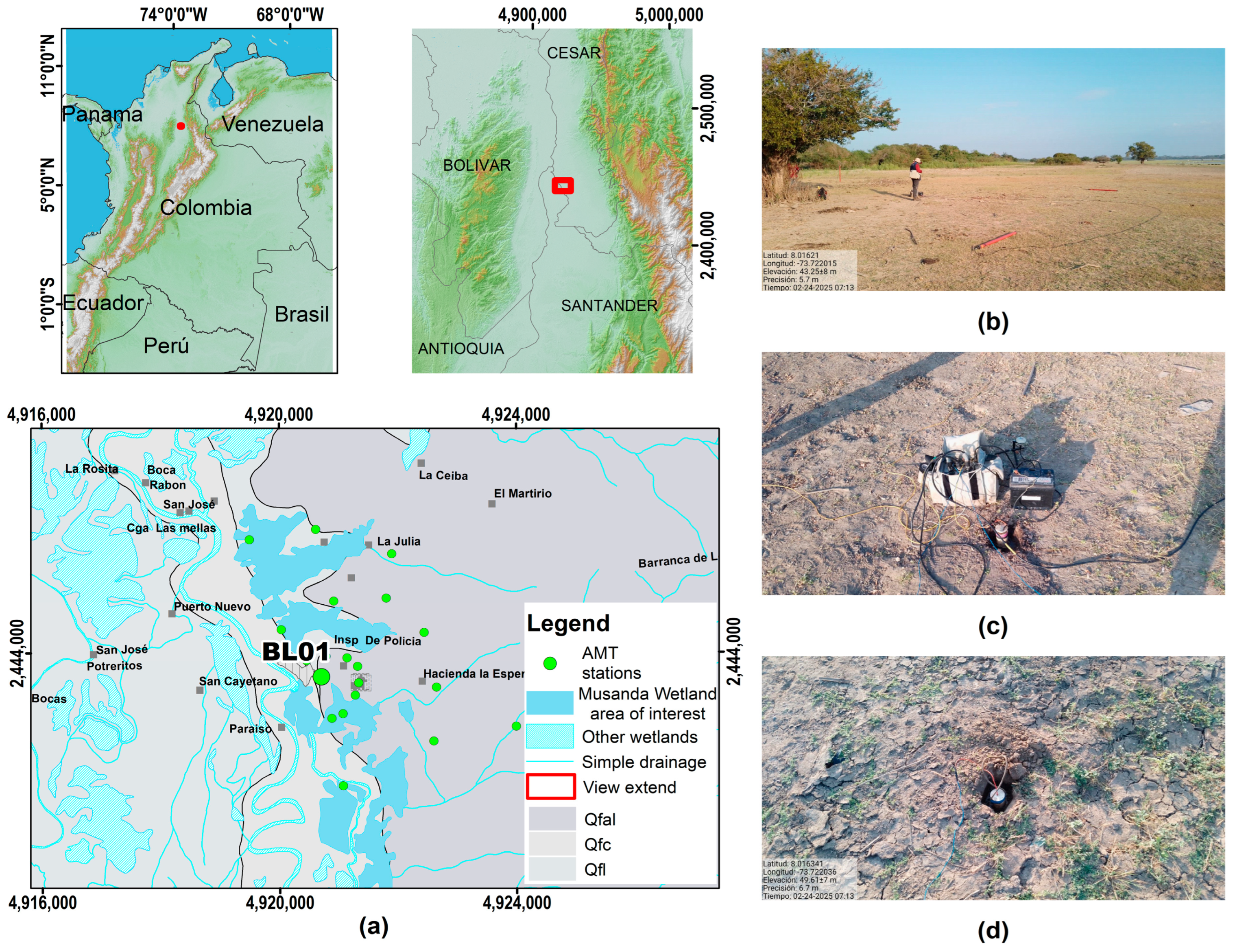
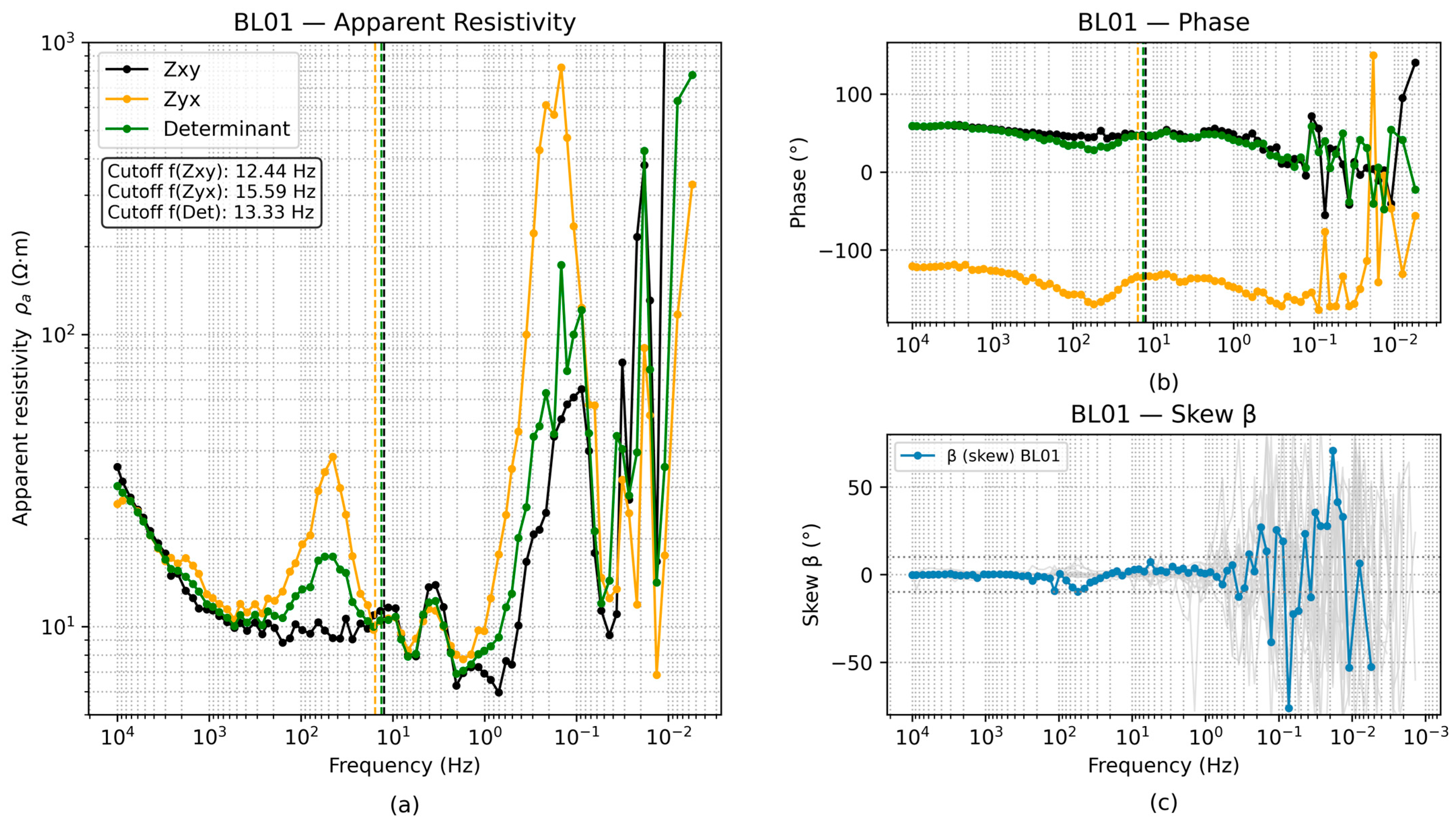

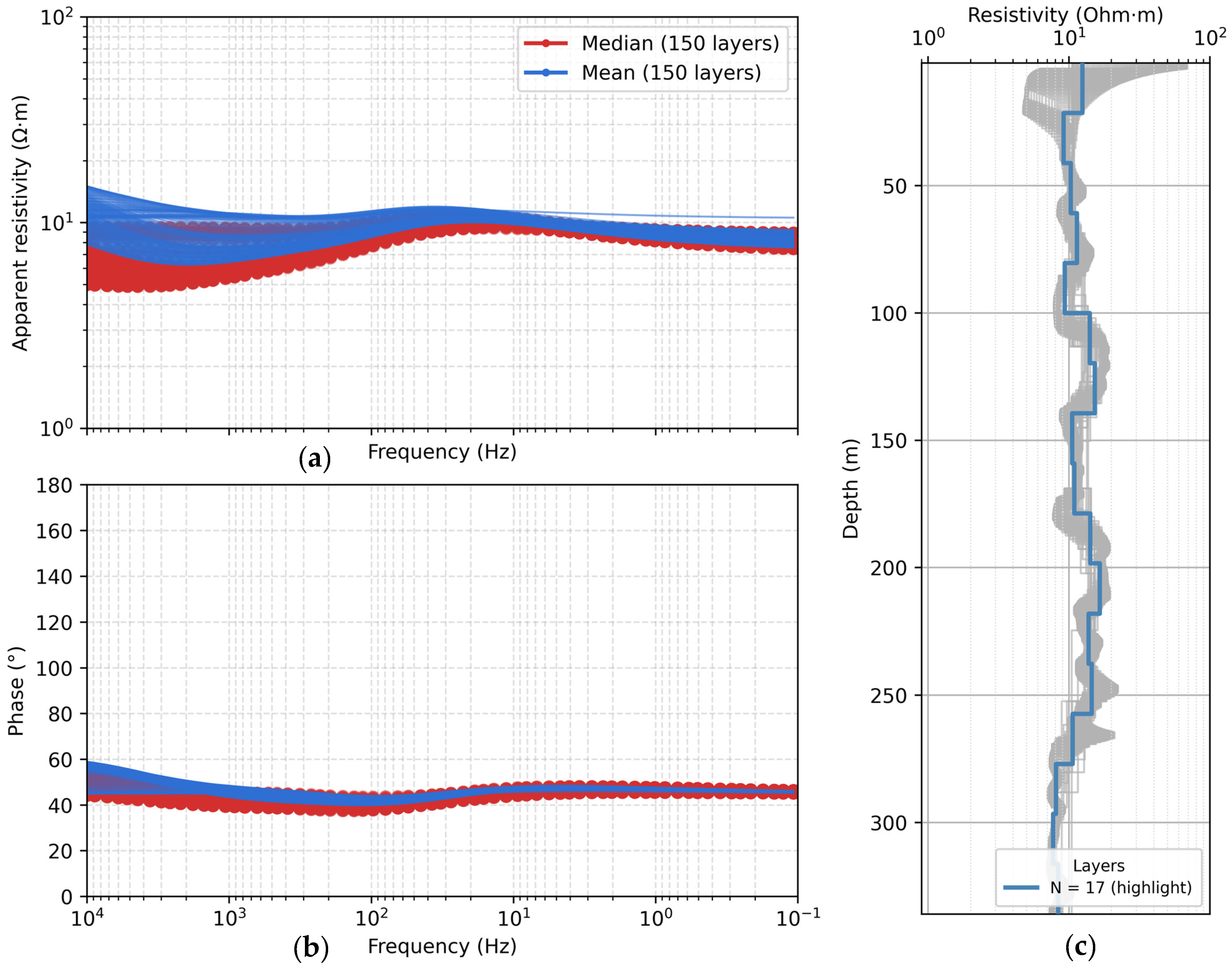
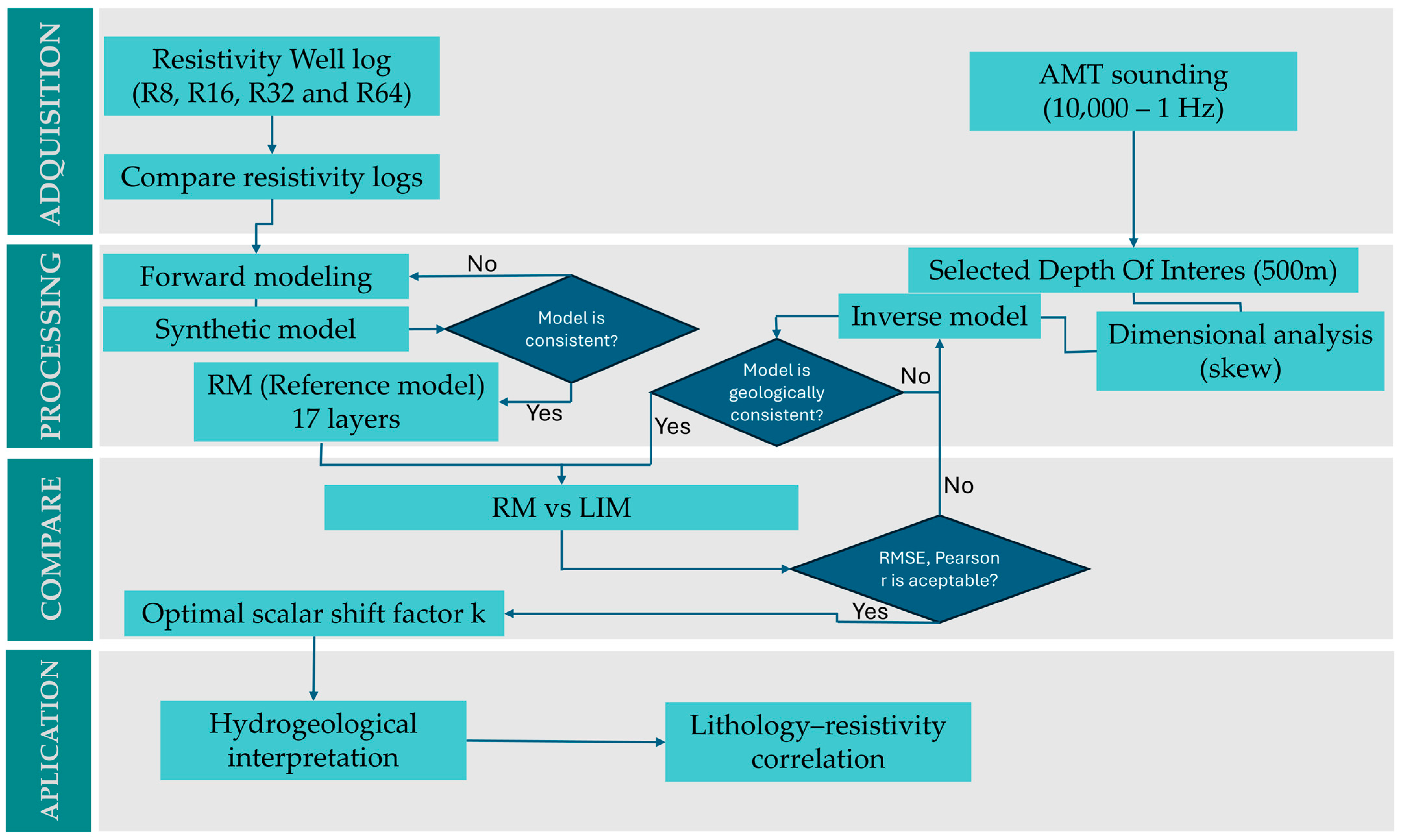
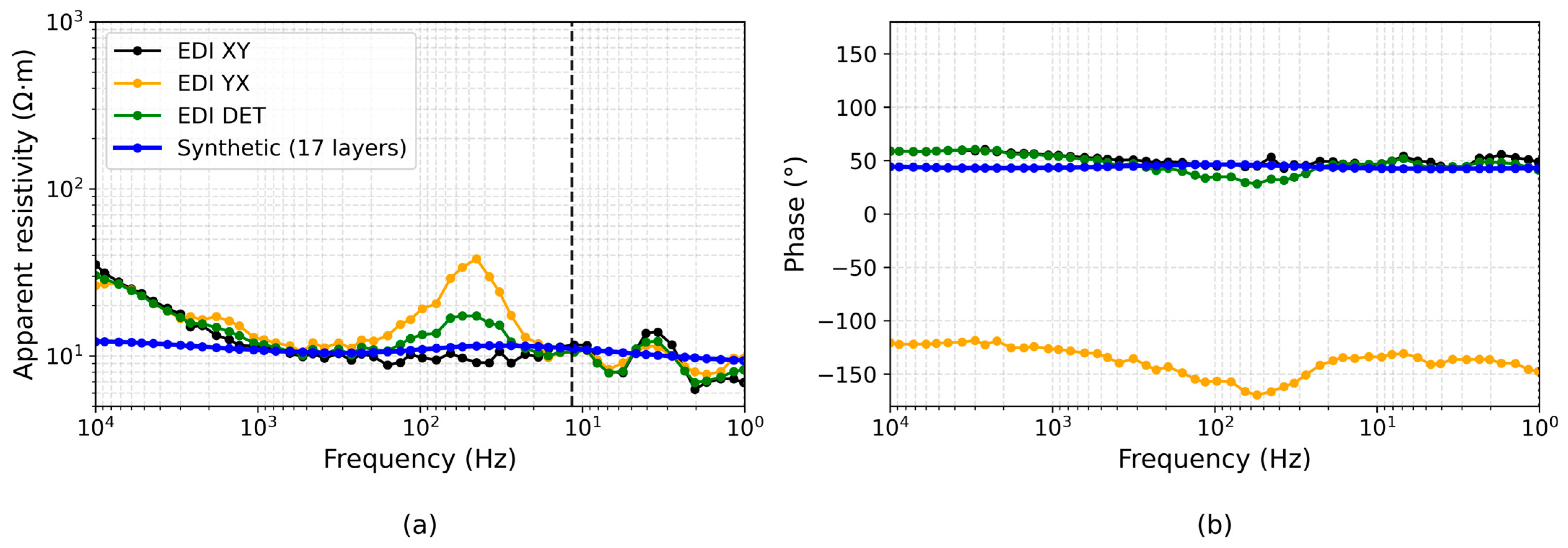


| Age | Formations | Tectonic Event | Depositional Environment |
|---|---|---|---|
| Triassic–Jurassic | Bocas, Noreán, and Girón | Rift | Continental to marginal |
| Jurassic–Paleocene | Cumbre, Rosablanca, Paja, Tablazo, Simití, and La Luna | Thermal subsidence | Fluvial, littoral, and marine |
| Late Paleogene | La Paz, Esmeraldas, Mugrosa, and Colorado | Compressional—onset of structural inversion | Continental |
| Neogene–Quaternary | Real Group and Quaternary deposits | End of structural inversion | Continental |
| Geological Unit | Lithology | Resistivity Range (Ω·m) | Depth Range (m) | Interpretation of Characteristics |
|---|---|---|---|---|
| Floodplain deposits (Qfal) | Muddy sands with gravels | 14–20 | 0–20.3 102.5–137.5 181.4–236.4 | The uppermost layer exhibits resistivity values of up to 35 Ω·m; however, it is the thinnest unit and is influenced by anthropogenic fill related to settlement activities. |
| Fluviolacustrine deposits (Qfl) | Clay with sand | 3–7 | 20.3–52.3 74.6–102.5 137.5–181.4 305.3–391.7 | – |
| Floodplain deposits (Qfal) | Sandy mud with gravels | 8–13 | 52.3–74.6 236.4–305.3 | Floodplain deposits are distinguished from other units by their higher proportion of fine-grained sediments |
| Real Group (N1r) | Sandstone | >30 | >391.7 | Basal group |
Disclaimer/Publisher’s Note: The statements, opinions and data contained in all publications are solely those of the individual author(s) and contributor(s) and not of MDPI and/or the editor(s). MDPI and/or the editor(s) disclaim responsibility for any injury to people or property resulting from any ideas, methods, instructions or products referred to in the content. |
© 2025 by the authors. Licensee MDPI, Basel, Switzerland. This article is an open access article distributed under the terms and conditions of the Creative Commons Attribution (CC BY) license (https://creativecommons.org/licenses/by/4.0/).
Share and Cite
Alvarado, H.; Pescador, J.; Landinez, J.; Piña, A.; Donado, L.D. Quantitative Integration of Audio-Magnetotelluric Sounding and Resistivity Well Logs for Groundwater Studies. Water 2025, 17, 3389. https://doi.org/10.3390/w17233389
Alvarado H, Pescador J, Landinez J, Piña A, Donado LD. Quantitative Integration of Audio-Magnetotelluric Sounding and Resistivity Well Logs for Groundwater Studies. Water. 2025; 17(23):3389. https://doi.org/10.3390/w17233389
Chicago/Turabian StyleAlvarado, Hernán, Juan Pescador, Juan Landinez, Adriana Piña, and Leonardo David Donado. 2025. "Quantitative Integration of Audio-Magnetotelluric Sounding and Resistivity Well Logs for Groundwater Studies" Water 17, no. 23: 3389. https://doi.org/10.3390/w17233389
APA StyleAlvarado, H., Pescador, J., Landinez, J., Piña, A., & Donado, L. D. (2025). Quantitative Integration of Audio-Magnetotelluric Sounding and Resistivity Well Logs for Groundwater Studies. Water, 17(23), 3389. https://doi.org/10.3390/w17233389






